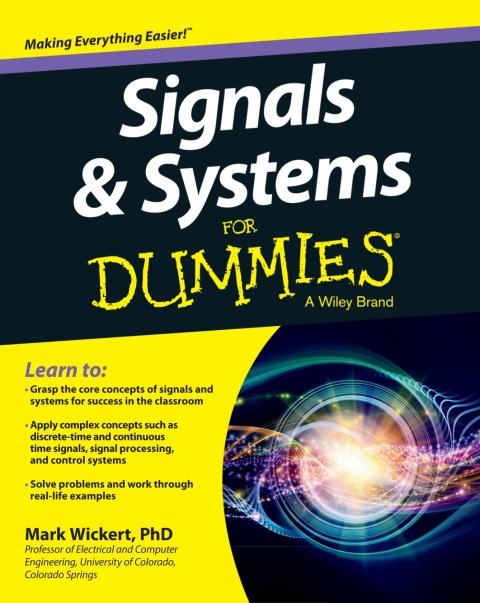Description
Efnisyfirlit
- About the Author
- Contents at a Glance
- Table of Contents
- Introduction
- About This Book
- Conventions Used in This Book
- What You’re Not to Read
- Foolish Assumptions
- How This Book Is Organized
- Icons Used in This Book
- Where to Go from Here
- Part I: Getting Started with Signals and Systems
- Chapter 1: Introducing Signals and Systems
- Applying Mathematics
- Getting Mixed Signals . . . and Systems
- Classifying Signals
- Signals and Systems in Other Domains
- Testing Product Concepts with Behavioral Level Modeling
- Exploring Familiar Signals and Systems
- Using Computer Tools for Modeling and Simulation
- Seeing the Big Picture
- Chapter 2: Brushing Up on Math
- Revealing Unknowns with Algebra
- Making Nice Signal Models with Trig Functions
- Manipulating Numbers: Essential Complex Arithmetic
- Catching Up with Calculus
- Finding Polynomial Roots
- Chapter 3: Continuous-Time Signals and Systems
- Considering Signal Types
- Getting Hip to Signal Classifications
- Transforming Simple Signals
- Checking Out System Properties
- Choosing Linear and Time-Invariant Systems
- Chapter 4: Discrete-Time Signals and Systems
- Exploring Signal Types
- Surveying Signal Classifications in the Discrete-Time World
- Computer Processing: Capturing Real Signals in Discrete-Time
- Classifying Systems in Discrete-Time
- Part II: Exploring the Time Domain
- Chapter 5: Continuous-Time LTI Systems and the Convolution Integral
- Establishing a General Input/Output Relationship
- Working with the Convolution Integral
- Stepping Out and More
- Chapter 6: Discrete-Time LTI Systems and the Convolution Sum
- Specializing the Input/Output Relationship
- Simplifying with Convolution Sum Properties and Techniques
- Working with the Convolution Sum
- Chapter 7: LTI System Differential and Difference Equations in the Time Domain
- Getting Differential
- Checking out the Difference Equations
- Part III: Picking Up the Frequency Domain
- Chapter 8: Line Spectra and Fourier Series of Periodic Continuous-Time Signals
- Sinusoids in the Frequency Domain
- General Periodic Signals: The Fourier Series Representation
- Chapter 9: The Fourier Transform for Continuous-Time Signals and Systems
- Tapping into the Frequency Domain for Aperiodic Energy Signals
- Getting Around the Rules with Fourier Transforms in the Limit
- LTI Systems in the Frequency Domain
- Chapter 10: Sampling Theory
- Seeing the Need for Sampling Theory
- Periodic Sampling of a Signal: The ADC
- Analyzing the Impact of Quantization Errors in the ADC
- Analyzing Signals in the Frequency Domain
- Applying the Low-Pass Sampling Theorem
- Reconstructing a Bandlimited Signal from Its Samples: The DAC
- Chapter 11: The Discrete-Time Fourier Transform for Discrete-Time Signals
- Getting to Know DTFT
- Working with Special Signals
- LTI Systems in the Frequency Domain
- Taking Advantage of the Convolution Theorem
- Chapter 12: The Discrete Fourier Transform and Fast Fourier Transform Algorithms
- Establishing the Discrete Fourier Transform
- The DFT/IDFT Pair
- DFT Theorems and Properties
- Computing the DFT with the Fast Fourier Transform
- Application Example: Transform Domain Filtering
- Part IV: Entering the s- and z-Domains
- Chapter 13: The Laplace Transform for Continuous-Time
- Seeing Double: The Two-Sided Laplace Transform
- Digging into the One-Sided Laplace Transform
- Checking Out LT Properties
- Getting Back to the Time Domain
- Working with the System Function
- Chapter 14: The z-Transform for Discrete-Time Signals
- The Two-Sided z-Transform
- The Region of Convergence
- Returning to the Time Domain
- Surveying z-Transform Properties
- Leveraging the System Function
- Chapter 15: Putting It All Together: Analysis and Modeling Across Domains
- Relating Domains
- Using PyLab for LCC Differential and Difference Equations
- Mashing Domains in Real-World Cases
- Part V: The Part of Tens
- Chapter 16: More Than Ten Common Mistakes to Avoid When Solving Problems
- Miscalculating the Folding Frequency
- Getting Confused about Causality
- Plotting Errors in Sinusoid Amplitude Spectra
- Missing Your Arctan Angle
- Being Unfamiliar with Calculator Functions
- Foregoing the Return to LCCDE
- Ignoring the Convolution Output Interval
- Forgetting to Reduce the Numerator Order before Partial Fractions
- Forgetting about Poles and Zeros from H(z)
- Missing Time Delay Theorems
- Disregarding the Action of the Unit Step in Convolution
- Chapter 17: Ten Properties You Never Want to Forget
- LTI System Stability
- Convolving Rectangles
- The Convolution Theorem
- Frequency Response Magnitude
- Convolution with Impulse Functions
- Spectrum at DC
- Frequency Samples of N-point DFT
- Integrator and Accumulator Unstable
- The Spectrum of a Rectangular Pulse
- Odd Half-Wave Symmetry and Fourier Series Harmonics
- Index






Reviews
There are no reviews yet.